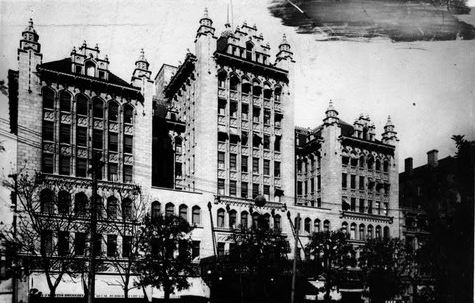A Word or Two about the Los Angeles Premiere of The Birth of a Nation
 In February, 1915, The Clansman, later titled The Birth of a Nation premiered at the Clune's Auditorium in Los Angeles (pictured above - now a parking lot). I want to say just a few words about 1) the public reaction and 2) how we think about this film today. Now, if you have been paying attention, you know that the film is as racist as it can be. For example, there are scenes depicting shoeless black people dancing, eating chicken, and leering at white women while serving in the South Carolina legislature during Reconstruction. If that's not enough - there are plenty of scenes of blacks lusting after white women (who have to kill themselves to avoid being raped).
In February, 1915, The Clansman, later titled The Birth of a Nation premiered at the Clune's Auditorium in Los Angeles (pictured above - now a parking lot). I want to say just a few words about 1) the public reaction and 2) how we think about this film today. Now, if you have been paying attention, you know that the film is as racist as it can be. For example, there are scenes depicting shoeless black people dancing, eating chicken, and leering at white women while serving in the South Carolina legislature during Reconstruction. If that's not enough - there are plenty of scenes of blacks lusting after white women (who have to kill themselves to avoid being raped).
By our standards, this film is an easy target. But the usual analysis by film historians is pretty flat. It goes something like this: Yes - the film is racist but innovative at the same time. D. W. Griffith set the bar for future film makers...blah blah blah. How much longer are film scholars going to keep blathering on about the same old stuff?
Scholars of Civil War history have looked at this film too. Some of them (myself NOT included) have noted that the film was met across the (white) nation with a sort of general acceptance. White people (North and South) in 1915 seemed to agree that Reconstruction was a bad deal for the South and that blacks should have been kept in their places. Thus, these white people could relate to the "heroic" KKK in the film's climax.
One reviewer at the 1915 LA premiere made a note of it. The audience applauded at scenes of whites triumphing over blacks attempting to assert their rights.
As modern observers, we have a tendency to recognize the widespread racism existing in 1915 and believe that most white people would get on board with the film's message. After all - The Birth of a Nation was a tremendous success all over the country - not just in the South.
But that may not be exactly right. Sure, white northerners were certainly racists by our standards but that didn't mean they supported the Confederate cause or the white South after the fact. Only 50 years earlier loyal citizens of the United States had fought a war to suppress a rebellion and the degeneration of law and order that the Confederate cause had represented. A film about mob rule was not necessarily a welcome thing. And just to add fuel to the fire, some of these guys who had shouldered muskets for the Union were still around to vent their anger!
And their legacy was still around too. Members of Union veterans' organizations like the GAR made sure that US citizens knew what that war had been about. And they were not about to let a Confederate interpretation take hold that easily.
With compliments,
Keith